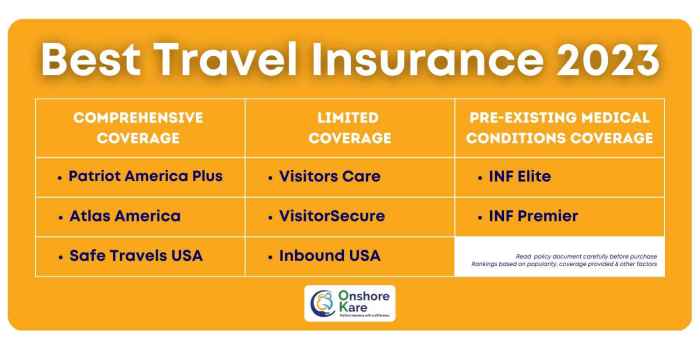
Embarking on a long-term journey requires meticulous planning, and securing comprehensive travel insurance is paramount. Unlike short trips, extended travel exposes individuals to a wider array of risks, necessitating coverage beyond standard tourist policies. This guide delves into the intricacies of selecting the ideal long-term travel insurance plan, considering factors such as trip duration, destination, and personal circumstances. We’ll explore various plan types, essential coverage areas, and crucial considerations to ensure a safe and worry-free extended adventure.
Understanding the nuances of long-term travel insurance is crucial for responsible and enjoyable extended journeys. From medical emergencies to lost luggage, unforeseen events can significantly impact your trip. This guide aims to empower you with the knowledge to make informed decisions, ensuring your chosen plan adequately protects your investment and well-being throughout your travels.
Defining “Long-Term Traveler”
Defining the term “long-term traveler” requires considering several factors beyond simply the duration of a trip. While a precise timeframe isn’t universally agreed upon, it distinguishes itself from short-term tourism through a combination of trip length, travel purpose, and lifestyle choices adopted during the extended period abroad.Long-term travel often implies a more immersive and less structured experience than typical short-term vacations.
The traveler actively engages with the local culture, potentially establishing temporary residence, and often forgoes the typical tourist trail in favor of deeper exploration and interaction with the local community. This contrasts sharply with the short-term tourist, who generally follows a pre-planned itinerary focused on sightseeing and specific attractions, often within a compressed timeframe. The unique needs and risks faced by long-term travelers stem from this extended immersion and the resulting increased exposure to various situations and potential unforeseen circumstances.
Trip Length and Traveler Type Comparison
The following table illustrates the typical trip lengths, common activities, associated risks, and corresponding insurance needs for short-term, mid-term, and long-term travelers. Understanding these differences is crucial in selecting the appropriate travel insurance plan.
| Trip Length | Typical Activities | Common Risks | Insurance Needs |
|---|---|---|---|
| Less than 2 weeks | Sightseeing, planned tours, cultural visits | Trip cancellations, lost luggage, minor medical issues | Basic travel insurance covering trip cancellations, medical emergencies, and lost luggage. |
| 2-4 weeks | Combination of sightseeing and more independent exploration, potentially including adventure activities | Increased risk of accidents, potential for more serious medical emergencies, theft | Comprehensive travel insurance with higher medical coverage, broader activity coverage, and potentially including emergency evacuation. |
| Over 4 weeks (Long-Term) | Extended stays in one or more locations, immersive cultural experiences, potential for volunteering or working remotely | Higher risk of prolonged illness or injury, potential for belongings damage or loss over time, extended medical expenses, repatriation needs | Comprehensive long-term travel insurance with extensive medical coverage, coverage for belongings over an extended period, emergency medical evacuation, and potentially repatriation assistance. Consider options with coverage for pre-existing conditions. |
Essential Coverage for Long-Term Travel Insurance

Securing the right travel insurance is paramount for long-term travelers, offering peace of mind and crucial financial protection against unforeseen circumstances. Unlike short trips, extended stays necessitate a policy that comprehensively addresses the unique risks and potential emergencies encountered over an extended period. Choosing a plan with adequate coverage is not merely a precaution; it’s a vital component of responsible and safe long-term travel.Choosing the right long-term travel insurance policy requires careful consideration of several key coverage areas.
These areas provide protection against a range of potential issues, ensuring you’re financially secure even when facing unexpected challenges far from home. The specific needs will vary depending on your destination and travel style, but certain elements remain consistently essential.
Medical Evacuation and Repatriation Coverage
Medical evacuation and repatriation are arguably the most critical aspects of long-term travel insurance. Medical emergencies can arise unexpectedly, and in remote locations or countries with limited medical facilities, the cost of evacuation to a hospital with appropriate care can be astronomical. Repatriation, the process of returning your remains to your home country in the event of death, also incurs significant expenses.
These services often involve specialized air ambulances and logistical coordination, making them extremely expensive without insurance.For example, imagine a scenario where a long-term traveler in Southeast Asia suffers a serious accident requiring immediate transfer to a specialized hospital in Singapore. Without adequate medical evacuation coverage, the cost of the air ambulance alone could easily exceed tens of thousands of dollars.
Repatriation coverage, similarly, can cost thousands depending on the distance and arrangements needed. Therefore, it is essential to check the policy limits for both medical evacuation and repatriation and ensure they are sufficient for your intended destinations and duration of travel.
Levels of Medical Coverage
Medical coverage varies significantly between insurance providers and policy tiers. Basic plans might offer limited coverage for medical expenses incurred during your trip, with relatively low maximum payout amounts. More comprehensive plans, however, provide substantially higher limits, often covering a broader range of medical services, including pre-existing conditions (subject to specific policy terms and waiting periods), emergency dental care, and even mental health support.Some providers offer tiered plans, allowing you to choose a level of coverage that aligns with your budget and risk tolerance.
For instance, a “budget” plan might offer a maximum payout of $50,000 for medical expenses, while a “premium” plan might offer $500,000 or more. The difference in cost between these plans should be weighed against the potential financial burden of a serious medical emergency. It is crucial to carefully review the policy documents to understand the extent of medical coverage, including exclusions and limitations.
Consider consulting with a travel insurance specialist to determine the appropriate level of coverage for your individual circumstances and planned activities.
Types of Long-Term Travel Insurance Plans
Choosing the right long-term travel insurance plan depends heavily on your travel style and needs. Different plans cater to various durations and activities, offering varying levels of coverage and cost. Understanding these differences is crucial for securing adequate protection during your extended travels.
Several distinct types of long-term travel insurance plans are available, each designed to meet the specific requirements of different travelers. The key differentiators often lie in the length of coverage, the types of activities included, and the overall cost. Below, we explore three common types.
Backpacker Plans
Backpacker plans are typically designed for budget-conscious travelers undertaking extended backpacking trips. They often offer more basic coverage compared to other options, focusing on essential medical emergencies and repatriation. These plans usually cater to younger travelers and those who are primarily engaging in low-risk activities.
- Key Features: Essential medical coverage, emergency medical evacuation, limited baggage coverage, potentially some trip interruption benefits.
- Benefits: Affordable premiums, suitable for budget travelers, covers basic needs for extended periods.
- Limitations: Often excludes adventure sports, may have lower coverage limits, limited or no coverage for pre-existing conditions.
Nomad Plans
Nomad plans are tailored to individuals who work remotely while traveling extensively. These plans often provide broader coverage, recognizing the higher risk associated with a more mobile lifestyle and the need for flexibility in coverage. They may include features accommodating changing locations and extended periods of stay in different countries.
- Key Features: Comprehensive medical coverage, emergency medical evacuation, higher coverage limits, potential for worldwide coverage, often includes coverage for lost or stolen equipment.
- Benefits: Flexibility to adapt to changing travel plans, wider geographical coverage, higher coverage limits for peace of mind.
- Limitations: Generally more expensive than backpacker plans, specific exclusions may apply to certain activities or locations.
Expat Plans
Expat plans are designed for individuals relocating to a foreign country for an extended period, often for work or studies. These plans provide more comprehensive coverage, often including coverage for longer durations and more extensive medical needs. They might also incorporate features relevant to settling into a new country, such as liability coverage.
- Key Features: Comprehensive medical coverage, emergency medical evacuation, long-term coverage options (often exceeding a year), potential for coverage of pre-existing conditions (with limitations), liability coverage.
- Benefits: Suitable for long-term stays, extensive medical coverage, potentially covers pre-existing conditions, offers peace of mind for extended periods abroad.
- Limitations: Significantly more expensive than other plans, often requires a more thorough application process.
Comparison of Long-Term Travel Insurance Plans
The following table summarizes the pros and cons of each plan type to aid in your decision-making process.
| Plan Type | Pros | Cons | Cost |
|---|---|---|---|
| Backpacker | Affordable, covers essentials | Limited coverage, excludes many activities | Low |
| Nomad | Comprehensive coverage, flexible, higher limits | More expensive, specific exclusions | Medium-High |
| Expat | Extensive coverage, long-term options, potential pre-existing condition coverage | Most expensive, rigorous application | High |
Factors Influencing Plan Selection

Choosing the right long-term travel insurance plan involves careful consideration of several key factors that significantly impact both cost and coverage. These factors are interconnected and should be evaluated holistically to ensure you secure a policy that adequately protects you throughout your extended travels. Failing to consider these aspects could lead to inadequate coverage or unexpectedly high premiums.
Age, pre-existing health conditions, and your chosen destination all play a crucial role in determining the price and availability of suitable long-term travel insurance. Understanding policy exclusions and limitations is equally important to avoid unpleasant surprises when you need to file a claim. A systematic approach to plan selection, based on your individual circumstances, is essential for securing comprehensive and cost-effective coverage.
Impact of Age, Health, and Destination on Plan Cost and Availability
Insurers assess risk based on several factors. Older travelers generally face higher premiums due to the increased likelihood of needing medical care. Pre-existing conditions can also significantly impact both cost and eligibility. Some insurers may exclude coverage for specific conditions, while others may offer coverage but at a substantially increased premium or with specific limitations. The destination also influences cost; travel to regions with higher healthcare costs or greater risk of certain events (e.g., political instability, natural disasters) will typically result in higher premiums.
For example, a 65-year-old with a history of heart problems traveling to a remote area of South America will likely pay considerably more than a 30-year-old healthy individual traveling to Western Europe.
Understanding Policy Exclusions and Limitations
Before purchasing any plan, thoroughly review the policy documents to understand what is and is not covered. Common exclusions might include pre-existing conditions (unless specifically covered with an added premium), adventure sports, hazardous activities, or certain types of medical treatments. Limitations may include caps on coverage amounts for specific events, such as medical expenses or lost luggage. For instance, a policy might cover medical expenses up to a certain limit, after which the traveler would be responsible for any additional costs.
Carefully reading the fine print will help you avoid unexpected financial burdens should an incident occur.
Step-by-Step Guide for Choosing a Suitable Long-Term Travel Insurance Plan
Selecting a suitable plan requires a methodical approach. Consider these steps:
- Assess your needs: Determine the length of your trip, your planned activities, your health status, and your budget. Consider the level of coverage you require for medical emergencies, evacuation, lost luggage, and other potential issues.
- Compare plans: Obtain quotes from multiple insurers, comparing coverage levels, premiums, and exclusions. Pay close attention to the details of each policy.
- Review policy documents: Carefully read the policy wording to fully understand the terms and conditions, including any exclusions or limitations. Don’t hesitate to contact the insurer to clarify anything you don’t understand.
- Consider additional coverage: Evaluate whether you need add-ons for specific activities or concerns, such as adventure sports coverage or cancellation insurance.
- Choose the right plan: Select the plan that best balances your needs, budget, and risk tolerance. Remember, the cheapest option isn’t always the best if it lacks essential coverage.
Beyond Insurance
Planning for extended travel requires more than just comprehensive insurance; it necessitates a strategic approach to resources, preparation, and ongoing support. This section delves into valuable tools and information to enhance your long-term travel experience, ensuring both safety and a fulfilling journey. It covers resources available to assist in planning, staying connected, and navigating unexpected situations.
Beyond securing the right travel insurance, several other resources prove invaluable for long-term travelers. These range from online platforms offering advice and community support to practical tools that simplify the logistics of extended journeys.
Helpful Resources for Long-Term Travelers
Accessing reliable information and support networks is crucial for successful long-term travel. The following resources offer diverse assistance, from planning itineraries to navigating emergencies abroad.
- Websites: Nomadic Matt (budget travel advice), The Points Guy (travel hacking and rewards), Lonely Planet (destination guides and travel information), Travelfish (Southeast Asia travel information), Rick Steves (Europe travel information).
- Apps: Google Translate (language translation), Google Maps (offline maps and navigation), XE Currency (currency converter), WhatsApp (communication), Duolingo (language learning).
- Organizations: Your home country’s embassy or consulate (emergency assistance), International SOS (medical assistance and security services), Global Rescue (medical evacuation and security services).
Essential Travel Gadgets and Apps
Specific tools and applications can significantly improve the long-term travel experience, enhancing safety, efficiency, and overall enjoyment. Investing in the right technology can streamline various aspects of your journey.
- Portable Power Bank: Essential for charging devices on the go, especially in areas with limited access to electricity.
- Universal Travel Adapter: Ensures compatibility with various power outlets worldwide.
- GPS Tracker (for valuables): Provides peace of mind by allowing you to locate important belongings.
- Packing Cubes: Optimize luggage space and organization.
- Offline Maps App (e.g., Maps.me): Provides navigation without relying on internet connectivity.
- VPN (Virtual Private Network): Enhances online security and privacy, especially on public Wi-Fi networks.
Types of Travel Blogs and Guides
Travel blogs and guides provide diverse perspectives and practical advice tailored to various travel styles and preferences. They serve as invaluable resources for planning, budgeting, and staying informed throughout your journey.
- Budget Travel Blogs: Focus on affordable travel options, tips for saving money, and finding budget-friendly accommodations (example: Nomadic Matt).
- Adventure Travel Blogs: Showcase adventurous activities like hiking, trekking, and extreme sports, offering insights into planning and safety (example: The Broke Backpacker).
- Slow Travel Guides: Emphasize immersive experiences, cultural immersion, and sustainable tourism, promoting a deeper understanding of destinations (example: many local tourism websites).
- Solo Female Travel Blogs: Offer advice and support specifically for women traveling alone, addressing safety concerns and providing practical tips (example: Adventurous Kate).
- Guides focused on specific regions or activities: Guides often specialize in a particular region (e.g., a guide to backpacking through Southeast Asia) or activity (e.g., a guide to cycling the TransAmerica trail).
Travel Deals and Destinations for Long-Term Travelers
Several destinations and travel deals cater specifically to the needs and preferences of long-term travelers. These options often offer cost-effectiveness, flexibility, and opportunities for immersive experiences.
- Southeast Asia (Budget backpacking): Countries like Thailand, Vietnam, and Laos offer affordable accommodation, food, and transportation, making them ideal for budget-conscious long-term travelers.
- South America (Adventure travel): Countries like Peru, Colombia, and Ecuador offer a blend of adventure activities, cultural experiences, and stunning landscapes, perfect for those seeking longer-term exploration.
- Digital Nomad Hubs (Remote work): Cities like Chiang Mai (Thailand), Lisbon (Portugal), and Medellin (Colombia) offer affordable co-working spaces, high-speed internet, and a vibrant community of digital nomads.
- House Sitting/Pet Sitting (Cost-effective accommodation): Websites like TrustedHousesitters and MindMyHouse connect travelers with homeowners who need someone to care for their pets or property in exchange for free accommodation.
- Volunteer Programs (Meaningful travel): Organizations like Worldpackers and Workaway offer opportunities to volunteer in exchange for accommodation and meals, providing a meaningful and immersive travel experience.
Choosing the right travel insurance for extended adventures is a significant step in ensuring a smooth and safe journey. By carefully considering the factors Artikeld in this guide—trip length, destination, health status, and desired coverage—you can confidently select a plan that aligns with your individual needs and budget. Remember, thorough research and a proactive approach to insurance are key to peace of mind while exploring the world for an extended period.
Bon voyage!
General Inquiries
What constitutes a “long-term trip” for insurance purposes?
Definitions vary by insurer, but generally, trips exceeding 3-6 months are considered long-term. Some insurers offer plans specifically designed for durations of a year or more.
Are pre-existing conditions covered by long-term travel insurance?
Coverage for pre-existing conditions varies greatly. Some insurers may offer limited coverage, while others may exclude them entirely. It’s crucial to disclose all pre-existing conditions during the application process.
Can I cancel my policy and get a refund?
Cancellation policies vary depending on the insurer and the reason for cancellation. Many policies allow for a refund, but usually with a significant deduction for administrative fees. Check your policy documents carefully.
What happens if I need medical evacuation?
If your policy includes medical evacuation, the insurer will arrange and cover the costs of transporting you to a suitable medical facility, often involving air ambulance services. This is a critical aspect of long-term travel insurance.






